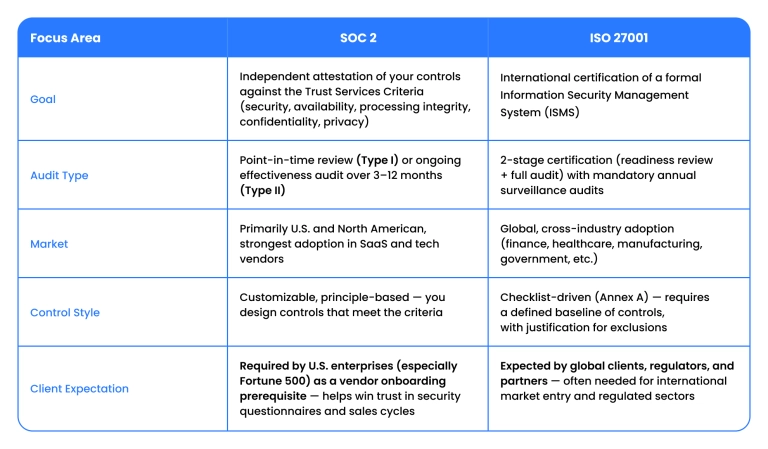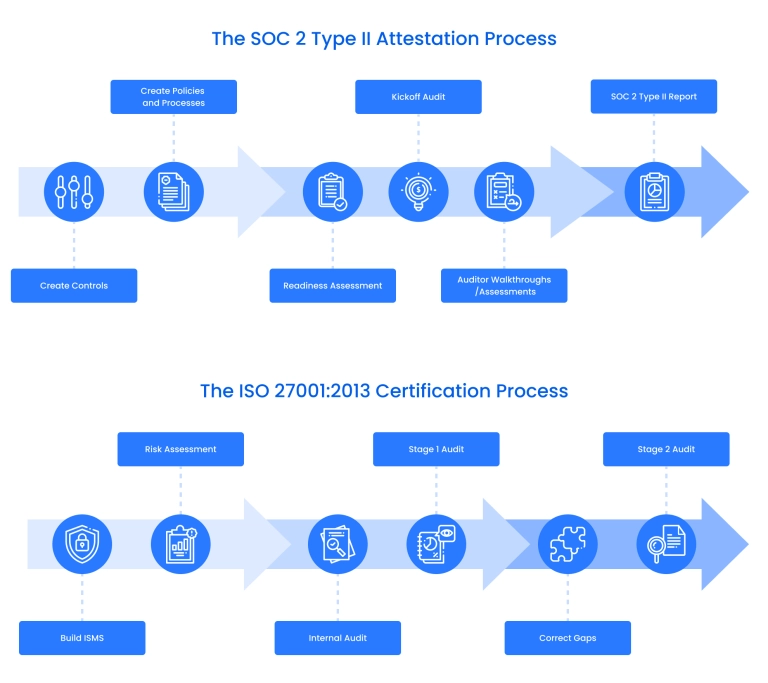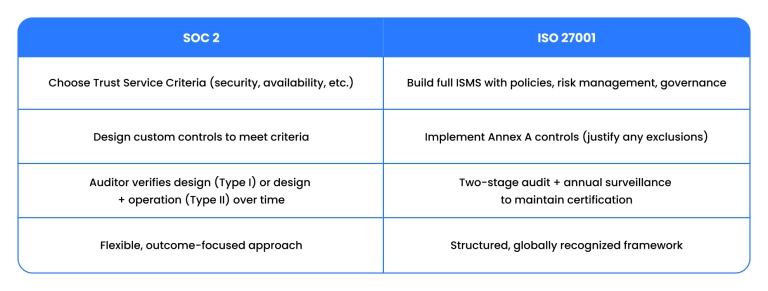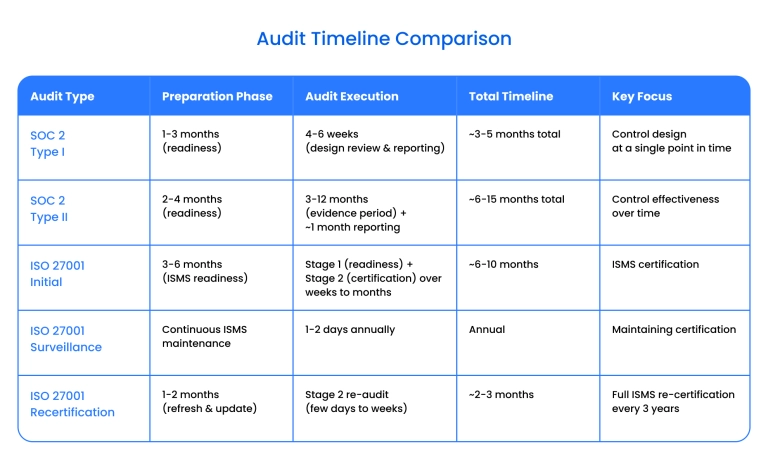A compliance project can cost you 25% of your entire revenue – but it can also lead to faster deals, fewer breaches, and save your teams 75% of their security review time. If you're stuck choosing between SOC 2 and ISO 27001, you're not just picking standards – you're deciding how your business builds trust, wins new customers, and stays ahead of shifting security expectations.
This guide strips away vendor hype and jargon so you can make the right call – or use both frameworks without burning through resources. We're talking real ROI numbers, workflow tips, and practical advice for tech leaders planning their next growth move.
- Key differences between SOC 2 and ISO 27001: framework goals, audit types, and what clients expect
- How compliance affects timelines, costs, and your strategic plans
- Side-by-side comparison of risk management and control approaches
- Clear steps for dual certification and streamlining your audit process
- Sector-specific guidance and future trends that will impact compliance
Framework overviews and core objectives
Choosing between SOC 2 and ISO 27001 often feels stressful, especially with client and regulatory pressure ramping up. Let's break it down and make your decision simple and confident.
What are SOC 2 and ISO 27001?
SOC 2 and ISO 27001 are top-tier security standards, but each plays a different role.
- SOC 2 (Service Organization Control 2) provides an attestation report. A qualified practitioner at a licensed CPA firm checks your security practices and confirms you meet specific criteria. Note: The individual auditor doesn't need to be a CPA themselves – they can be other qualified professionals working under the firm's supervision.
- ISO 27001 delivers a formal certificate. You build an information security management system (ISMS) based on global standards, then an accredited body reviews your setup and gives you a certificate.

SOC 2 vs ISO 27001: Attestation or certification
It comes down to the kind of proof you want:
- SOC 2 attestation: After a qualified practitioner at a CPA firm reviews your controls, you get a report showing how well you meet the trust service criteria. It's not a simple pass/fail; it's an expert's judgement, backed by evidence.
- ISO 27001 certification: Your policies and routines are tested against applicable controls selected through your risk assessment process, and you're either certified or not. The certificate works worldwide and gives you serious credibility.
When choosing, ask yourself what your clients care about: a straightforward attestation, or an internationally recognized certification?

Framework architecture
Let's see how each standard operates:

SOC 2 says, "Show us your controls, and prove they work." ISO 27001 wants you to build a system, prove it works every day, then earn international trust as a result.
Market focus: U.S. vs International reach
SOC 2 and ISO 27001 often get compared based on where your customers are:
- SOC 2 comes from U.S. accounting standards, so American SaaS and tech buyers expect it. If you're pitching Fortune 500s in the U.S., SOC 2 is almost always required. However, many European and international organizations also accept SOC 2, especially in SaaS and cloud services sectors.
- ISO 27001 is international. Europe, Asia, the Middle East, and global clients look for it as proof of best practices. If you're planning international growth, ISO 27001 pays off.
Map your client base and look at the security questions they send. Are you focused on the U.S., or do you need global status?
Control flexibility: Custom or checklist
Who writes the rules?
- SOC 2 lets you design controls for your particular business. You select the trust criteria that matter, and controls are customizable. Auditors look for enough evidence that your processes meet their standard.
- ISO 27001 uses a risk-based approach to select from Annex A controls. You choose applicable controls based on your risk assessment and can exclude others with proper justification. If you skip a control, you need to explain your risk assessment in your Statement of Applicability.
SOC 2 is good for teams needing flexibility in control design. ISO 27001 is ideal if you want the structure and recognition a global risk-based framework offers.
Audit processes and compliance considerations
Facing compliance headaches or worried about never-ending audits? You're not alone. Here's a simple breakdown so you can move forward confidently – shipping features, winning sales, and building a happier team.
SOC 2 type I vs type II and the ISO 27001 audit phases
SOC 2 and ISO 27001 have very different audit flows:
- SOC 2 Type I: Checks your control design on one date. It's a quick snapshot to prove you set things up correctly.
- SOC 2 Type II: Requires a minimum 3-month testing period – auditors test whether your controls actually work over time. This testing period can extend to 12 months, but 3 months is the regulatory minimum. This is what major clients ask for.
- ISO 27001: Hosts a two-stage process. Stage 1 (document review and readiness check), Stage 2 (live process audit). You'll also have annual surveillance audits to keep your certificate valid.
SOC 2 is more about trust services; ISO 27001 goes wider, auditing your info security management system. Your market and business priorities determine which route makes sense.
Audit timelines and documentation
Want to avoid roadblocks? Here’s what timelines and paperwork look like:

Cost and strategic planning
Audits play rough on budgets. Current market investment typically ranges $25,000–$100,000+ for initial certification:
- SOC 2: $20k–$75k+ for audits (significantly higher for Type II), plus costs for preparation, consulting, and compliance software.
- ISO 27001: $25k–$70k+ to start, plus annual invoices ($10k-$25k) for surveillance audits.
Both frameworks require annual renewal: SOC 2 Type II reports typically need annual renewal to maintain credibility with clients, while ISO 27001 requires annual surveillance audits.
Where does the money go?
- Consultants to get you ready
- Staff time for training and documentation
- Tools to automate or show evidence
- Ongoing maintenance and annual renewal costs
Tips for spending wisely:
- Start planning early – don't wait for customer requests to get urgent.
- Map your controls across both frameworks; cut duplicate work.
- Assign a project owner to drive progress and clear blockers.
Dual certification: Save time and effort
Going after both standards isn't just for the big players – but requires careful planning due to different audit cycles and evidence requirements:
- Map controls: Many requirements overlap. Cover them once and use for both audits.
- Shared documents: Policies, procedures, and logs should serve both SOC 2 and ISO 27001 needs.
- Automation tools: Compliance platforms keep evidence, changes, and communication in one place for all standards.
- Review regularly: Maintain controls year-round – not just before each audit.
- Coordinate timing: Plan audit schedules carefully – SOC 2 Type II requires annual renewal while ISO 27001 uses 3-year certification cycles with annual surveillance.
Work with a partner familiar with both standards to help your team upskill and avoid common mistakes.
Risk management: How each framework handles threats
- SOC 2: Requires formal risk assessment processes under Common Criteria 3.1, targeting data privacy, security, and service risks.
- ISO 27001: Makes risk management central – a comprehensive risk assessment, regular updates, and action plans are required as part of the ISMS.
Both frameworks require systematic risk management processes – the difference is in scope and formality.
Smart steps:
- Prioritize assets with the highest exposure.
- Use simple risk matrices ("likelihood" vs "impact") for clarity.
- Get leadership buy-in for risk treatments – don't let security sit with IT alone.
Whichever framework you choose, good risk management shields your business from surprises and drives audit success.
Security controls, risk management, and systemic improvements
Security isn't just policies – it's how you build trust and keep customers comfortable. If you're comparing SOC 2 and ISO 27001, you want clear answers on which helps you feel confident and keeps your business truly protected. Here's a direct look at security controls, risk management, and continuous improvement – so you know what's practical for daily operations.
Keeping data security front and center
Both SOC 2 and ISO 27001 push you to put data protection at the top of your list:
- Confidentiality: Sensitive data stays protected.
- Integrity: Information is accurate and up-to-date.
- Availability: Systems are ready for customers – no downtime drama.
SOC 2 uses five Trust Service Criteria, while ISO 27001 sticks to confidentiality, integrity, and availability (the "CIA triad"). Whichever you choose, expect a thorough look at your security routines.
Ongoing risk assessments
Threats never stop, and neither does risk management.
- ISO 27001 makes risk assessments a formal, regular event – part of your ISMS.
- SOC 2 requires formal risk assessment processes under Common Criteria 3.1, with regular reviews and updates as part of your control environment.
Both standards expect you to continuously improve. ISO 27001 uses a "Plan-Do-Check-Act" model. SOC 2 asks you to review controls and keep them sharp.
Advice: Risk assessments keep your team proactive – not just reacting after something goes wrong.
Why ISMS matters
For ISO 27001, your Information Security Management System ties together all your security policies, roles, and routines. Here's why it's a big deal:
- Accountability: Everyone knows their job and who to report to.
- Structure: Problems get flagged, policies get updated – nothing slips through.
- Proof: Auditors can see exactly how you operate.
SOC 2 doesn't ask for a formal ISMS, but expects you to stick to whatever controls you promise. Fast-moving startups might find an ISMS heavy at first, but it helps with growing pains as your team and risks grow.
If you're still asking whether to pick SOC 2 or ISO 27001, think about how much structure works for your team, and how demanding your clients will be.
Risk management techniques: SOC 2 vs ISO 27001
Here's a quick side-by-side to make things clearer:
| Feature | SOC 2 | ISO 27001 |
| Security Approach | Process-driven with flexible control design | Process-driven, ISMS required |
| Risk Assessment | Required under Common Criteria 3.1 | Formal, periodic, documented |
| Control Implementation | Customizable design | Risk-based selection from Annex A |
| Improvement Loop | Ongoing reviews | PDCA cycle, formal correction |
Both frameworks are process-driven and require formal risk management. SOC 2 allows more flexibility in control design. ISO 27001 uses a structured risk-based approach for control selection. Fast-moving startups might lean SOC 2. Large, international firms go ISO 27001 for its credibility.
Custom controls vs mandated controls
Deciding between SOC 2 and ISO 27001?
- SOC 2 makes life easier for companies with custom workflows, giving you flexibility in how you design and implement controls.
- ISO 27001 provides a structured, risk-based framework that you can build upon for stricter needs or more complex risk profiles.
Bottom line: Find the framework that helps you sleep well, lets your people work efficiently, and keeps customers and auditors satisfied. We're right there alongside you throughout the journey.
Implementation, ROI, and organizational impact
Compliance goes beyond ticking boxes – it’s a way to show your value and help your team grow.
ROI and cost-benefit: Tangible wins
Let's tackle the real question: Is it worth the investment?
- Audit and prep: $25,000–$100,000+ depending on your size and needs, with ongoing annual costs of $15,000–$40,000.
- Staff/consultant time: Takes 6–12 months for most companies.
Direct benefits:
- Faster, larger deals: Sales cycles drop by up to 50% after certification.
- Less busywork: Teams save up to 75% on security review hours.
- Fewer breaches: Stronger controls cut incident rates – especially around access and phishing.
- Enterprise access: Many large enterprises require SOC 2+ (additional criteria beyond basic five) or ISO 27001 as minimum qualifications.
The return is measured in growth, customer confidence, and team relief – not just dollars spent.
Sector-specific guidance
Match your audit with your business model:
- Fintech/APIs: US customers want SOC 2 right away for speed and local fit. May also need PCI DSS compliance for payment processing.
- Global SaaS: Choose ISO 27001 to unlock deals in Europe and Asia.
- Healthtech: Often need both: SOC 2 for workflows, plus HIPAA compliance for healthcare data and ISO 27001 for privacy and international compliance.
- Startups: SOC 2 is usually faster for US deals, while ISO 27001 works well for rapid international growth.
- Government/Defense: May require FedRAMP, CMMC, or other specialized frameworks regardless of business preference.
Industry-specific regulations may override framework choice – assess your regulatory requirements first.
Future trends: Where compliance is heading
Regulation is getting tougher. More European firms want ISO 27001, while US buyers push for SOC 2 renewals every 12 months. AI governance, remote work security, and supply chain risk mean you'll face tighter controls and more frequent updates.
Emerging trends include:
- Continuous monitoring and automated compliance tools
- SOC 2+ requirements with additional custom criteria
- Integration with AI and machine learning governance
- Enhanced focus on supply chain and vendor risk management
Both frameworks are evolving. Expect ongoing vendor audits, continuous monitoring, and new security requirements – flexibility today, but lasting habits tomorrow.
Final thoughts
SOC 2 vs ISO 27001 isn't just technical jargon – it's about building trust, landing deals, and growing your business confidently. Whether you value SOC 2's flexibility or want the global stamp ISO 27001 brings, you invest in security for your customers and your team.
The right framework fits your goals, makes day-to-day work smoother, and delivers real ROI. If you want direct guidance, skilled support, and a true partnership – not just another vendor – contact Binariks. We work with you at every step, making compliance clear and straightforward.
Share

